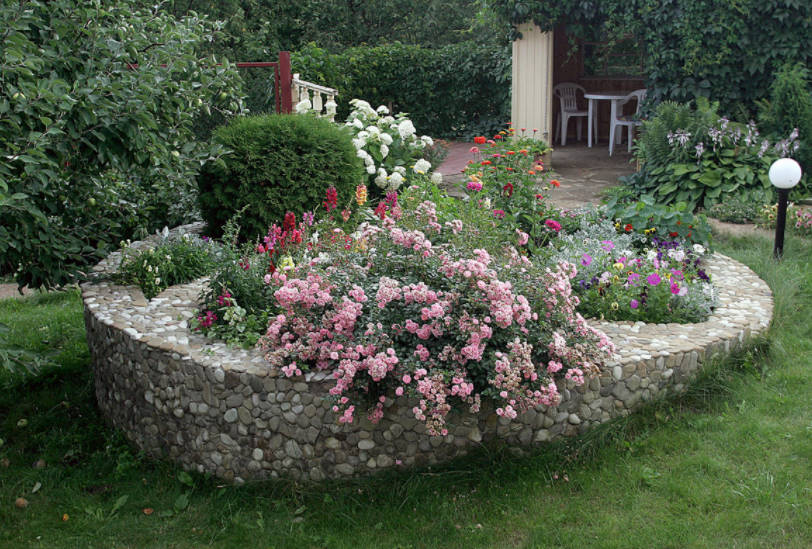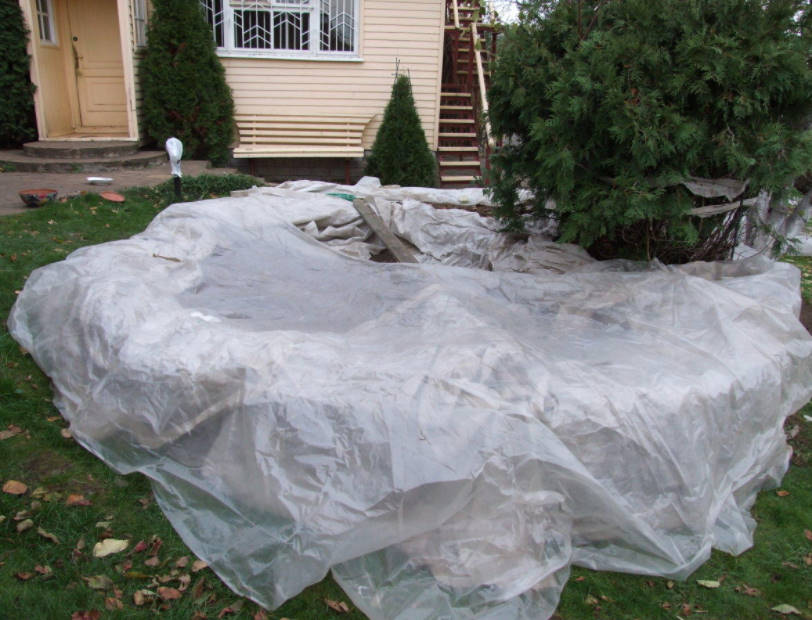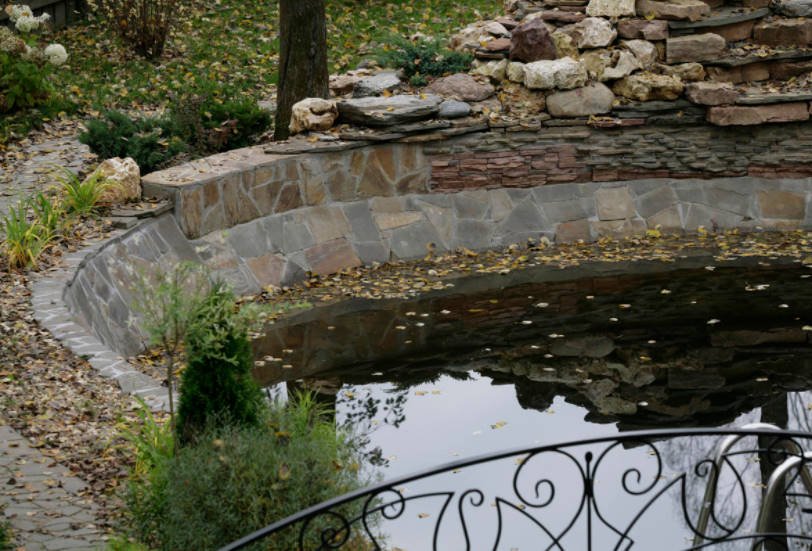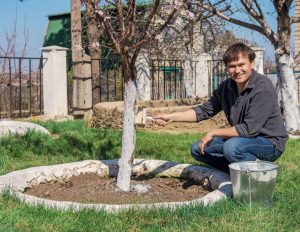
A garden is not just about plants, it’s all about it. So economic objects are also its full-fledged components. What might be missing here and how to fix it?
Error 1. Household items and accessories that were not prepared for the winter
Take a walk in the garden and see every detail! Special attention is paid to metal containers. First of all, they can suffer from frost.
- Watering barrels should be tilted and placed on one side.
- The same thing should be done with the wheelbarrow.
- If you have a summer washbasin in the garden, wrap it in plastic wrap and tie it up.
- Spunbond and film are wrapped on street cranes.
- Inspect all the sheds, barns: whether there are water tanks, solvents, lacquers, paints, chemical plant protection products – they do not tolerate frost, you need to collect them and lower them to the basement or to another warm place.
- Pour the liquid out of the sprayers.
- Collect the hoses and store them in the basement.
- Tools are washed and lubricated with the cutting part of the oil, you can even vegetable.
Error 2. Forget about the design on the area
Shelter for the winter also applies not only to plants, but also to garden structures. This applies to some types of decorative reservoirs, three-dimensional stone products, as well as to the design, finished with small objects: pebbles, gravel, mosaics of broken tiles and other materials. For all of them, the cycles of freezing and thawing are disastrously alternating. Therefore, creating such an exquisite beauty in the garden, it can be lost in 2-3 seasons, if not hidden from frost and sleet. Additional work, and what to do? But this prevents huge costs.

Any beauty needs to be covered up
Here is a rough list of what you need to cover for the winter:
- The sides of flower beds and the finishing of retaining walls, if they are lined with mosaics, pebbles or gravel.

A wlower bed of pebbles should be covered for the winter
It is necessary to close the dry structure.First, lutrasil of medium thickness was laid, then glassine, old linoleum or leatherette. Cover the top with plastic wrap and secure it with bricks.

Shingle-covered flower bed
Similarly, cover any elements of the garden decor, if they have a mosaic.
- Garden fireplace (grill)made of stone or finished with stone , if it is not under a canopy.

Stoves and barbecues do not need to be hidden under a canopy
The top of the dry structure is covered with two layers of thin lutrasil, and on top with a plastic film, and also tied around with a synthetic rope and bricks are tied to the bottom hook. In the same way, you can hide a fountain made of stone.
- Garden pond or pool on a concrete base.
If your pond is exactly like this (and not a plastic bowl you bought), you need to drain the water from it for the winter. If there is still some water at the bottom, put some brick blocks so that they “take” the frost. After that, the pond must first be covered with boards with a small distance between them, then put metal sheets, plastic, old linoleum – any material that you have on the board. From above, cover everything with either strips of leatherette, or thick polyethylene, and secure with bricks.

The tank on the concrete base must be pumped out and closed
Ponds based on the film for the winter can not be drained.
- Garden lights
If your lamps are not too high – no higher than 1.2 m (1.3 yard), then in winter it is better to remove the lantern, remove the light bulb, put a cut plastic bottle on the “legs”, and tie plastic bags on top. Plafonds are quite fragile and can crack under the weight of snow. Also, some models of lamps can not withstand sudden temperature changes.
Error 3. Did not prepare the country house for the winter
The house also needs to be prepared, because in winter you will certainly pay a visit to the dacha. To make it comfortable for you to be there, even for a short time, you need to quickly insulate it. I’m not talking about building insulation. This operation is serious, it requires time, effort and materials.
Fundamental insulation is necessary if you decide to live in the house in the winter. And I’m talking about the routine, the rush, when you only go there a couple of times during the whole winter. This is easy to do, but you need to know what to deal with, where the main culprits are heat loss. They are always there, even with the most careful compliance with building regulations (of course, if your cottage was not originally insulated during construction). Even if the house has a stove, electric heaters or heating, with large heat losses, it turns out that you heat the street, that is, any heating is inefficient. And the cold and damp spoil the design of the decoration of the house and furniture, because many people leave all the furniture (equipment) for a winter holiday in a country house, without taking it to the city.
Heat losses occur in the following directions and in this proportion:
- walls-40%,
- roof-20 %,
- Windows-15 %,
- Floor-10 %,
- ventilation is also 10 %.
The latter, however, is easy to adjust – for the “winter mode”, a mechanism is provided in the ventilation grille that allows you to reduce the holes. But ventilation in the house is necessary, so there’s nothing you can do about it. Well, with the remaining losses, you can successfully fight. To do this:
- On all the doors in the house, a special tape of insulation is pasted around the perimeter.
- Windows can be insulated as follows: sew a long bag-“sausage” from a beautiful fabric, fill it with cotton wool or polyester and lay it along the window sill. Another way to decorate the insulation is to put cotton wool between the frames, and on it-bunches of mountain ash. It will all look amazing inside and out.
- It happens that the cold goes through the corners. For example, in frame houses, the corners are cold bridges. With proper construction, they provide for the so-called labyrinth seals. Well, in addition, you can insulate the corners with built-in corner furniture, especially from the winds.
- The cold is coming through the floors in the house. Of course, the basis is the right design. Floors should be made according to the rules-double, with black floors, insulation (preferably mineral wool) and waterproofing. But if, alas, the floor is not made quite according to the rules or there are cracks on it, it can be covered with carpets or carpet, preferably in two layers. A large number of woven textile mats “work” very effectively: they need to be laid overlapping to cover the entire floor.
- If the house has a wood-burning stove and you use it when you come to the country, its effectiveness can also be improved by temporarily laying a niche with a fire-resistant brick (without mortar, just by hand). These bricks will additionally take, and then radiate heat. But where and how to store firewood in the country, you already know.
That’s all I have, I hope this article was useful for you and now you know how to keep warm in your country house.




Leave a Reply